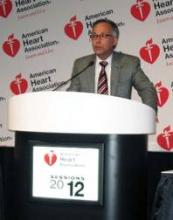LOS ANGELES – The idea that raising blood levels of high-density lipoprotein cholesterol will cut cardiovascular events in patients with coronary disease took another hit with the flat clinical impact of dalcetrapib in a pivotal phase III trial with more than 15,000 patients.
Dalcetrapib did what it was supposed to do, at least physiologically: It raised patients’ HDL cholesterol levels by an average of about 30% compared with placebo. Despite that, patients who received the drug showed absolutely no drop in cardiovascular event rates during a median 31 months’ follow-up, Dr. Gregory G. Schwartz reported at the annual scientific sessions of the American Heart Association.
Because of the lack of any suggestion of benefit from treatment, the trial’s Data and Safety Monitoring Board recommended stopping the dal-OUTCOMES trial because of futility at one of the study’s prespecified review points.
The disappointing result made dalcetrapib, a cholesterol ester transfer protein (CETP) inhibitor, the second agent from this class to strike out in phase III testing. Five years ago, torcetrapib, the first CETP inhibitor drug to enter advanced clinical testing, crashed and burned in a phase III trial when it significantly boosted patient morbidity and mortality despite raising HDL cholesterol by 72% and cutting LDL levels by 25%, possibly because torcetrapib also boosted systolic blood pressure by an average of about 5 mm Hg (N. Engl. J. Med. 2007;357:2109-22).
Dalcetrapib was not nearly as dangerous as torcetrapib. In the new study, treatment with dalcetrapib was linked to a modest, average 0.6-mm rise in systolic blood pressure, and an equally slight 0.2-mg average increase in blood levels of C-reactive protein. Whether these effects had an impact on the clinical bottom line remains unknown, but the study results showed that the primary efficacy event curve for patients on dalcetrapib was completely superimposed with the curve for patients on placebo, reported Dr. Schwartz, chief of cardiology at the Denver VA Medical Center.
Both Dr. Schwartz and Dr. Alan Tall, the designated discussant for the study at the meeting, agreed that the disappointing performances of dalcetrapib and torcetrapib in phase III trials did not automatically mean that the CETP drug class has totally washed out. They both cited the importance of waiting for results from two other phase III studies now in progress that are testing two more CETP agents that are molecularly distinct from the two that did not pan out. Those agents are anacetrapib, currently being tested in a 30,000-patient study, the REVEAL (Randomized Evaluation of the Effects of Anacetrapib Through Lipid-Modification) trial, with results expected in 2017; and evacetrapib, now being tested in an 11,000-patient study, the ACCELERATE (Assessment of Clinical Effects of Cholesteryl Ester Transfer Protein Inhibition With Evacetrapib in Patients at a High-Risk for Vascular Outcomes) trial, with results expected in 2015.
"All four drugs have different chemical structures and biological effects," and so the outcomes seen so far with dalcetrapib and torcetrapib "are not necessarily harbingers" of what might lie ahead with the anacetrapib and evacetrapib trials, said Dr. Tall, professor and director of the Center of Research in Molecular Medicine and Atherosclerosis at Columbia University in New York.


